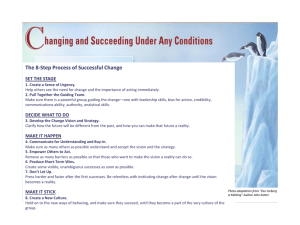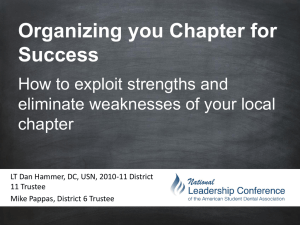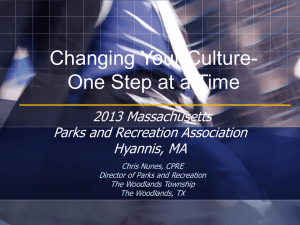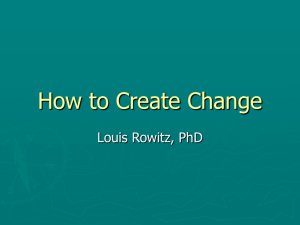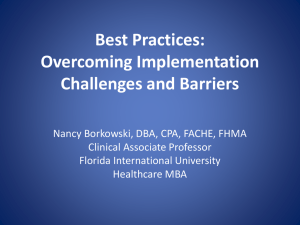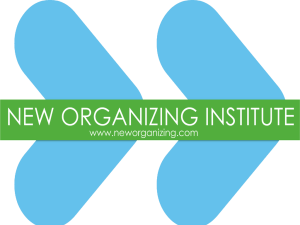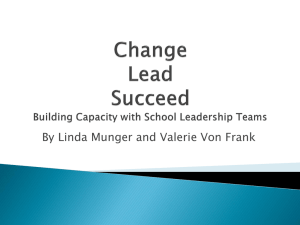Change Management
advertisement
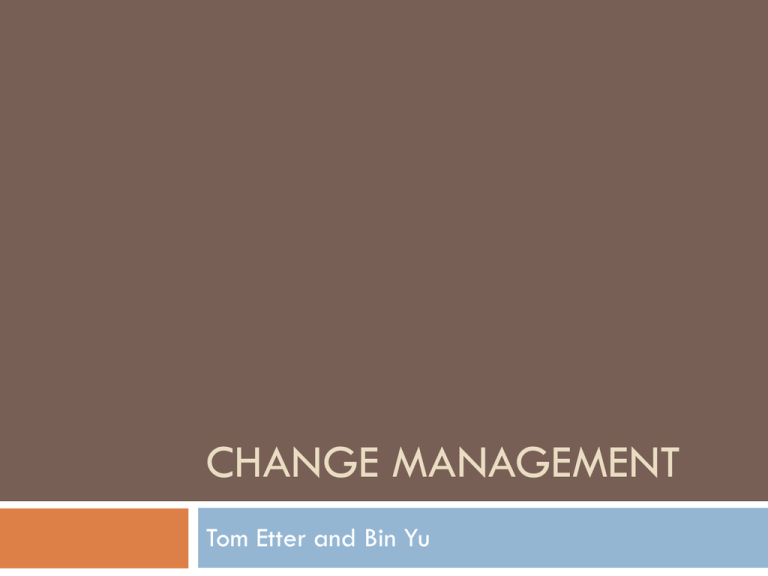
CHANGE MANAGEMENT Tom Etter and Bin Yu Change Management Most change efforts fail Two thirds fail because of failure to reach intended results Efforts at “reengineering” experience a 70% failure rate Companies who fail to sustain significant change end up facing crises John Kotter – 8 phases of driving successful change 8 Steps to Managing Change 1. 2. 3. 4. 5. 6. 7. 8. Establish a Sense of Urgency Form a Powerful Guiding Coalition Create a Vision Communicate the Vision Empower Others to Act on the Vision Plan for and Create Short-Term Wins Consolidate Improvements and Produce More Change Institutionalize New Approaches 1. Establish a Sense of Urgency Exhibit Vulnerability in Organization Examine market and competitive realities Identify and discuss crises, potential crises, or major opportunities 1. Establish a Sense of Urgency Over 50% of organizations fail to create a sense of urgency Underestimate the difficulty in moving people from their comfort zone. Lack of patience Complacency 1. Establish a Sense of Urgency Sources of Complacency Too much happy talk from senior management The absence of a major and visible crisis Too many visible resources Low overall performance standards Organizational structures that focus employees on narrow functional goals Internal measurement systems that focus on the wrong performance indexes A lack of sufficient performance feedback from external sources A kill-the-messenger, low-candor, low-confrontation culture Human nature, with its capacity for denial, especially if already busy/stressed ? 1. Establish a Sense of Urgency When is the level of urgency high enough? When 75% of leadership honestly believes a change is necessary. 1. Establish a Sense of Urgency Ways to raise urgency level Create a crisis Allowing financial loss Exposing managers to weaknesses Allowing for error Eliminate obvious examples of excess Company jet, country club, etc. Set performance targets so high they can’t be reached by conducting business as usual Insist on more productivity and broader measures of performance 2. Form A Powerful Guiding Coalition Assemble group with enough power to lead change effort Encourage the group to work together as a team Regardless of size, needs at least 3-5 people Grow team to 20-50 range in large companies Failures due to: No history of teamwork at top Undervalue importance Strong sense of urgency not established Selecting wrong leadership 2. Form A Powerful Guiding Coalition Building the coalition Find the right people Strong position power Broad expertise High credibility Create trust Carefully planned off-site events Lots of talk and joint activities Develop common goal Sensible to the head Appealing to the heart 3. Create A Vision Create vision for directing change effort Develop strategies for achieving that vision A vision says something that clarifies direction The vision pulls the organization toward the change 3. Creating A Vision Characteristics of an effective vision Imaginable Desirable Feasible Focused Flexible Communicable 3. Vision Example The University of New Hampshire (UNH) is nationally recognized as a Sustainable Learning Community* -- a land grant, sea grant, and space grant university that unites the spirit of discovery with the challenge of sustainability across its Curriculum, Operations, Research and Engagement: • Curriculum: Educating citizen-professionals to advance sustainability in their civic and professional lives • Operations: Embodying first principles and best practices of sustainability • Research: Serving society with scholarship that responds to the most pressing issues of sustainability • Engagement: Collaborating locally to globally with extension and outreach -- through four initiatives designed around four foundational systems of sustainability – biodiversity, climate, food, and culture. 3. Create A Vision Example University of New Hampshire Sustainable Learning Community Land grant, sea grant and space grant university Unites the spirit of discovery with the challenge of sustainability across its 4 initiatives.... Curriculum Operations Research Engagement ....designed around 4 foundational systems of sustainability.... Biodiversity Climate Food Culture 4. Communicate the Vision Management must decide how much communication of the vision is needed Do not limit it to one communication Use deeds along with words Will fail unless most members.... Understand Appreciate Commit Try to make happen effort happen Use every existing communication channel and opportunity 4. Communicate the Vision Key Elements in Effective Communication of a Vision: Simplicity Metaphor, analogy and example Multiple forms Repetition Leadership by example Explanation of seeming inconsistencies Give-and-take 5. Empower Others to Act on Vision Eliminate obstacles to change Change systems or structures that seriously undermine the mission Encourage risk taking and nontraditional ideas, activities and actions Make tough decisions in removing people who don’t ascribe to the vision 5. Empower Others to Act on Vision Barriers to Empowerment Employees understand the vision & want to make it a reality but are boxed in by.... Formal structures making it difficult to act A lack of needed skills undermines action Personnel & information systems make it difficult to act Bosses discourage actions aimed at implementing the new vision 5. Empower Others to Act on Vision Empowering people to effect change Communicate a sensible vision to employees Make structures compatible with the vision Provide the training employees needed Align information & personnel systems to the vision Confront supervisors who undercut needed change 6. Planning for & Creating Short-Term Wins Create and plan for visible performance improvements Recognize and reward employees involved in the improvements 6. Planning for & Creating Short-Term Wins The Value of Short-Term Wins Provide evidence that sacrifices are worth it Reward change agents with pat on the back Help fine-tune vision and strategies Undermine cynics and self-serving resisters Keep bosses on board Build momentum 7. Consolidate Improvements & Sustain Momentum For Change Use increased credibility to change systems, structures and polices that don’t fit the vision. Hire, promote & develop employees who can implement the vision. Reinvigorate the process with new projects, themes and change agents. Confront even bigger issues and problems. Change Management >Project Management Project vs. Change Management 24 Project Management is the application of knowledge, skills, tools and techniques to project activities to meet project requirements (i.e. to affect change). Change Management is the process, tools and techniques to manage the people-side of change to achieve the required business outcome (i.e. to assure the change is accepted; not rejected). Change Management Project Management Adopted from Prosci Research Change vs. Project Management New: • Processes • Systems • Org Structure • Job Roles 25 Existing: • Processes • Systems • Org Structure • Job Roles Project Management Current State Transition Period Future State Change Management Person affected by existing: • Processes • Systems • Org Structure • Job Roles Person successfully transitions / accepts new: • Processes • Systems • Org Structure • Job Roles Continous Improvement Change Management Processes/ Tools 26 Provides situational awareness. Helps us “Get Ready” •Output examples: •Change characteristic profile •Organizational attributes profile •CM Strategy •CM Team Structure •Sponsor assessment; roles Create Plans, then execute them. Five “should’s”: •Communication Plan •Sponsor Roadmap •Training Plan •Coaching Plan •Resistance Management Plan Ensure the change is Sustained. Output examples: •Reinforcement mechanisms •Compliance audit reports •Corrective action plans •Recognition approaches •Success celebrations •After action review Change Management Competency Organizations must change faster than was previously required in response to a rapidly changing world; managing the people-side of change is essential to successful change. Level Organizational CM competency is evident in all Continuous process CM competency can be measured via Prosci’s Maturity Model: 5 Competency levels of the org and is part of the improvement in place org’s IP and competitive edge Level 4 Organizational Standards Organization-wide standards and methods are broadly deployed for managing / leading change Selection of common approach, which is normally used by most areas of the firm Level 3 Multiple Projects Comprehensive approach for CM applied in multiple projects Some examples of best practice are evident Level 2 Isolated Projects Some elements of CM are applied in some individual projects Many different tactics used inconsistently Level 1 Ad hoc or Absent Little or no CM applied People-dependent; no formal practices / plans Highest probability and responsiveness Highest rate of project failure, productivity loss Tips for Successful Change Management 28 Involve staff from all levels in the change Constantly assess strategies Be conscious of ripple effects Distinguish between urgent and important Show strong, united leadership Consider emotional and behavioral issues Confront the brutal facts but keep the faith From Barbara Johnson, PhD

